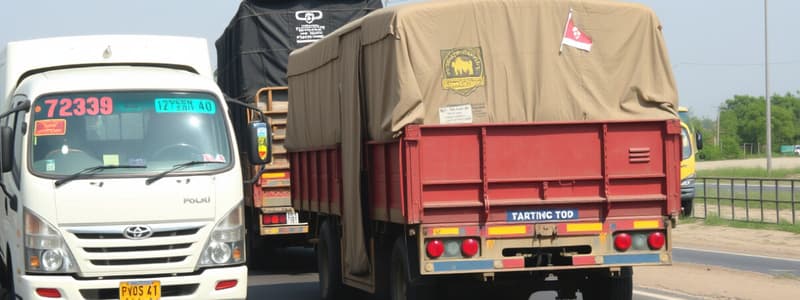Podcast
Questions and Answers
Which mode of transportation is primarily known for its speed and long-distance capabilities?
Which mode of transportation is primarily known for its speed and long-distance capabilities?
- Water Transportation
- Pipeline Transportation
- Air Transportation (correct)
- Land Transportation
Which of the following is NOT an example of water transportation?
Which of the following is NOT an example of water transportation?
- Ferries
- Trains (correct)
- Ships
- Boats
What is a key feature of pipeline transportation?
What is a key feature of pipeline transportation?
- It allows for the continuous flow of liquids and gases. (correct)
- It involves multiple modes of transport.
- It mainly transports passengers.
- It is exclusively for transporting solid goods.
Which mode of land transportation is powered solely by human or animal effort?
Which mode of land transportation is powered solely by human or animal effort?
Which mode of transportation is characterized by the use of standardized containers?
Which mode of transportation is characterized by the use of standardized containers?
In which type of transportation are blimps and hot air balloons included?
In which type of transportation are blimps and hot air balloons included?
Which option accurately describes a benefit of land transportation?
Which option accurately describes a benefit of land transportation?
Which of the following type of transportation is typically used for bulk goods?
Which of the following type of transportation is typically used for bulk goods?
Which of the following is a common characteristic of air transportation?
Which of the following is a common characteristic of air transportation?
What distinguishes intermodal transportation from other modes?
What distinguishes intermodal transportation from other modes?
Flashcards are hidden until you start studying
Study Notes
Transport Modes Overview
- Modes of transport refer to various means designed for transporting people and goods.
- Common modes include automobiles, buses, trains, ships, and airplanes.
- Transportation occurs on land, air, water, and through pipelines.
Land Transportation
- Involves movement over terrestrial routes, offering versatile door-to-door service.
- Motorized Examples:
- Automobiles: Common for personal travel and commuting.
- Trucks: Essential for freight and cargo transport.
- Buses: Used for public transit and intercity travel.
- Cars: Widely utilized for personal transport.
- Motorcycles: Provide a faster, smaller alternative for individual travel.
- Trains: Efficient for high-capacity transport of passengers and goods.
- Human- or Animal-Powered Examples:
- Bicycles: Eco-friendly option for short distances and personal use.
- Boards: Include skateboards and similar modes for individual transport.
- Carts: Often used for transporting goods in various settings.
Air Transportation
- Known for speed, primarily used for long-distance travel and high-value or perishable goods.
- Examples:
- Planes: Key for commercial and cargo air travel.
- Jets: Fastest form of air transport for long distances.
- Rockets: Used for space travel and exploration.
- Helicopters: Provide access to hard-to-reach areas and quick medical transport.
- Drones: Increasingly used for deliveries and surveying.
- Recreational Usage:
- Hot Air Balloons: Used for leisure flights.
- Blimps: Often for advertising or entertainment.
- Gliders/Hang Gliders: For recreational flying.
Water Transportation
- An alternative mode primarily used for bulk goods across oceans, rivers, lakes, and canals.
- Examples:
- Ferries: Transport people and vehicles across bodies of water.
- Ships: Large vessels used for cargo and passenger transport.
- Boats: Smaller craft for local transport needs.
Pipeline Transportation
- Specialized for continuous flow of liquids and gases over long distances.
- Commonly used for crude oil, petroleum, chemicals, and coal.
- Pipeline systems have unlimited routing capabilities, both on land and underwater.
Intermodal Transportation
- Involves the use of multiple transport modes within a single logistic chain.
- Utilizes standardized containers for enhanced efficiency and flexibility.
- Essential for global supply chains, providing seamless transitions between transport methods.
Studying That Suits You
Use AI to generate personalized quizzes and flashcards to suit your learning preferences.




